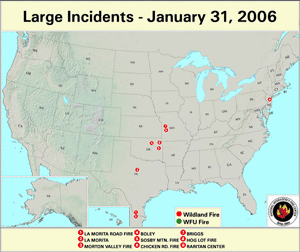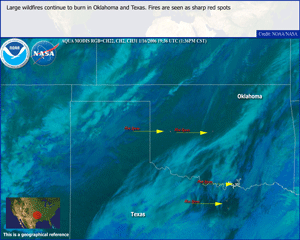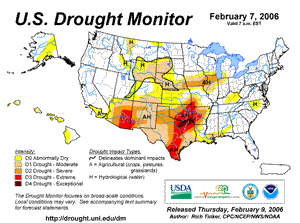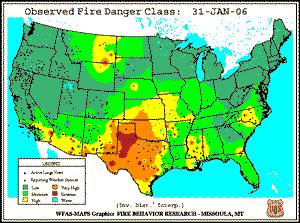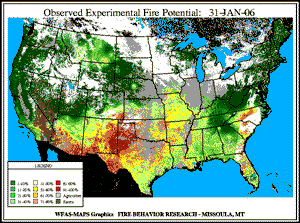Wildfire activity that had initially developed at the end of 2005 continued across parts of the central and southern U.S. during January 2006. Over 3700 fires have occurred since the beginning of the year, with numerous large fires in the central and southern Plains region. Especially hard hit were Oklahoma and Texas, where long–term drought conditions worsened during the latter half of 2005, but fire activity also spread to the Southwest and Front Range regions later in the month. Several large fires continued to burn into early February 2006 in Texas, Oklahoma and Missouri.
Preliminary estimates from the National Interagency Fire Center suggest that over 330,000 acres had burned across the U.S. by the end of January, with over 260,000 acres in the southern Plains region. Fire activity during winter is normally low across the U.S., and both the number of fires and the burned acres are unusually large for this time of year.
At the end of January, fire activity developed across parts of Florida and southern Georgia. More recently, dry conditions combined with offshore Santa Ana winds have increased fire risk and activity across Southern California.
| Totals as of January 31st | Nationwide Number of Fires | Nationwide Number of Acres Burned |
|---|---|---|
| 2006 | 3,507 | 330,447 |
| 2005 | 505 | 1,620 |
| 2004 | 859 | 8,294 |
Dead fuel moisture levels across the southern and central Plains states decreased during January. In particular, fine fuel moisture levels (i.e., 10–hour fuels) were extremely dry, with levels below 5% across most of Texas and Oklahoma. Unusually dry fine fuels were also measured across parts of Kansas, Arizona and New Mexico at the end of the month.
Medium to larger fuels (i.e., the January 31st 100–hr and January 31st 1000–hr fuel moistures) were also unusually dry for the winter, especially across the Southwest, the Front Range and the southern Plains areas.
The Keetch–Byram Drought Index (KBDI), a widely used index for fire risk, had the largest potential for wildland fire activity in the contiguous U.S. across parts of the central and southern Plains at the end of January. In addition, the observed fire danger classification and experimental fire potential index were also anomalously high for the southern Plains region for winter.
For further information on drought conditions across the U.S. go to the January drought summary page.
 NOAA's National Centers for Environmental Information
NOAA's National Centers for Environmental Information
